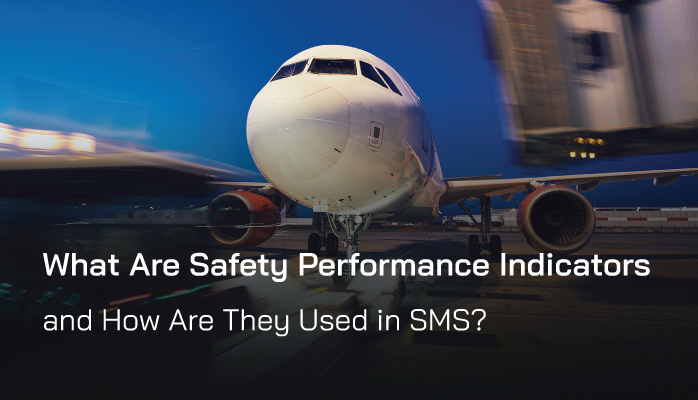Safety Performance Indicators (SPIs)

Safety is the cornerstone of aviation operations, and for safety managers, ensuring compliance with regulations and fostering a proactive safety culture is paramount.
A critical tool in achieving this is the Safety Management System (SMS), which relies heavily on Safety Performance Indicators (SPIs) to measure, monitor, and improve safety performance.
But what exactly are SPIs, and how do they function within an SMS? This article explores the definition, purpose, and practical application of SPIs in aviation safety management, offering actionable insights for safety managers looking to enhance their safety programs.
What Are Safety Performance Indicators (SPIs)?
Safety Performance Indicators (SPIs) are measurable metrics used to assess the effectiveness of an organization’s safety management processes. Trained quality-assurance managers know SPIs under another name: Key Performance Indicators (KPIs), which is the preferred term in quality management systems. As the name suggests, SPIs focus on "safety."
Related Aviation KPI Articles
- What Is a Key Performance Indicator (KPI) in Aviation SMS? - With Free KPI Resources
- 6 Sources for Aviation Key Performance Indicators - With Free KPI Resources
- Signs of Good KPIs in Aviation SMS
SPIs provide data-driven insights into safety performance, enabling aviation operators—such as airlines, airports, or maintenance organizations—to identify trends, detect potential risks, and implement corrective actions before incidents occur.
SPIs are a core component of an aviation SMS, which is a systematic top-down approach to managing safety risks as mandated by the International Civil Aviation Organization (ICAO) and national civil aviation authorities like the Federal Aviation Administration (FAA) or European Union Aviation Safety Agency (EASA). SPIs can be leading indicators, which predict potential safety issues, or lagging indicators, which reflect past performance based on incidents or accidents.
For example:
- Leading SPI: The percentage of employees completing safety training on time.
- Lagging SPI: The number of runway incursions reported in the past quarter.
By tracking these indicators, safety managers can gauge whether their SMS is functioning effectively and align their safety objectives with regulatory requirements.
Related Aviation KPI Articles
- Understand Aviation SMS KPIs Lagging and Leading Indicators
- How to Automate Key Performance Indicator KPI Monitoring in Aviation SMS
- How to Set and Monitor Key Performance Indicators (KPIs) in Existing SMS
Why Are SPIs Important in Aviation Safety Management?
Aviation is an industry where the stakes are extraordinarily high. A single oversight can lead to catastrophic consequences, making proactive safety management essential. SPIs serve several critical functions within an SMS:
-
Proactive Risk Identification: SPIs help safety managers identify emerging risks before they escalate into incidents. For instance, an increase in near-miss reports could signal underlying issues in air traffic control procedures.
-
Performance Monitoring: SPIs provide a quantifiable way to monitor safety performance over time, ensuring that safety objectives are being met.
-
Regulatory Compliance: ICAO’s Annex 19 requires aviation organizations to implement an aviation SMS, including SPIs, to demonstrate compliance with safety standards.
-
Continuous Improvement: By analyzing SPI data, organizations can refine their processes, enhance training programs, and strengthen their safety culture.
-
Stakeholder Confidence: Transparent reporting of SPIs builds trust among regulators, employees, and passengers, reinforcing an organization’s commitment to safety.
How Are SPIs Developed?
Developing effective SPIs is a structured process that requires collaboration between safety managers, operational teams, senior leadership and in many cases, your civil aviation authority (CAA) representative. Here’s a step-by-step guide to creating SPIs for your SMS:
1. Define Safety Objectives
Start by identifying the safety goals of your organization. These objectives should align with your SMS policy and address key risk areas, such as runway safety, maintenance errors, or human factors. For example, an objective might be to “reduce ground handling incidents by 10% within 12 months.”
2. Identify Key Risk Areas
Conduct a safety risk assessment to pinpoint areas of concern. Use tools like hazard identification, incident reports, or safety audits to gather data. For instance, if ramp operations are a frequent source of incidents, you might focus SPIs on ground vehicle collisions or equipment damage.
3. Select Measurable Metrics
Choose indicators that are specific, measurable, achievable, relevant, and time-bound (SMART). Examples include:
- Percentage of flights delayed due to safety-related issues.
- Number of safety reports submitted per month.
- Frequency of maintenance errors detected during inspections.
4. Establish Baselines and Targets
Determine a baseline for each SPI based on historical data, then set realistic targets for improvement. For example, if your current rate of runway incursions is 2 per 10,000 operations, you might aim to reduce this to 1.5 within a year.
5. Implement Data Collection Systems
Ensure you have robust systems for collecting and analyzing SPI data. This might involve integrating safety reporting software, leveraging flight data monitoring systems, or training staff to report hazards consistently.
6. Monitor and Review
Regularly review SPI performance during safety meetings or through SMS audits. Adjust targets or redefine SPIs as needed to reflect changes in operations or regulations.
Types of SPIs in Aviation SMS

SPIs can be categorized based on their focus within the SMS framework. Here are some common types, along with examples:
Operational SPIs
These focus on day-to-day operations and are often tied to specific activities, such as:
- Flight Operations: Rate of go-arounds due to unstable approaches.
- Ground Operations: Number of baggage handling injuries per 1,000 flights.
- Air Traffic Control: Frequency of loss-of-separation events.
Organizational SPIs
These measure the health of the safety culture and management processes, such as:
- Training Compliance: Percentage of pilots completing recurrent training on schedule.
- Safety Reporting: Number of voluntary safety reports submitted annually.
- Audit Findings: Number of unresolved findings from internal safety audits.
Related Articles on Aviation SMS Audits
- Real Difference Between an Aviation Safety Audit vs. Inspection
- How to Conduct Internal SMS Audits in Aviation Industry
- 5 Ways to Prepare for Aviation SMS Audits
Outcome-Based SPIs
These reflect the results of safety performance, typically lagging indicators, such as:
- Incident Rates: Number of bird strikes per 10,000 flights.
- Accident Rates: Number of accidents per million flight hours.
- Near-Miss Events: Frequency of near-collisions reported by crew.
Practical Applications of SPIs in SMS
To illustrate how SPIs are used in practice, let’s explore a few real-world scenarios:
Scenario 1: Reducing Runway Incursions
An airport safety manager notices an increase in runway incursions. They develop an SPI to track the number of incursions per 10,000 operations. After analyzing data, they identify a correlation between incursions and poor visibility conditions. The manager implements targeted training for air traffic controllers and pilots, resulting in a 20% reduction in incursions within six months.
Scenario 2: Enhancing Safety Reporting
An airline’s safety culture is suffering due to low employee engagement in reporting hazards. The safety manager introduces an SPI to measure the number of voluntary safety reports submitted per month. To encourage reporting, they launch an awareness campaign and simplify the reporting process. Within a year, the number of reports doubles, providing valuable data to address emerging risks.
Scenario 3: Improving Maintenance Reliability
A maintenance organization tracks an SPI for the rate of unscheduled maintenance events caused by human error. By analyzing SPI data, they discover that errors peak during night shifts. The organization introduces fatigue management training and adjusts shift schedules, leading to a significant decrease in errors.
Related Fatigue Risk Management Articles- 3 Ways for Dealing With Fatigue Risk Management in Aviation SMS
- How to Best Monitor Fatigue in Your Aviation SMS
- Winter Fatigue Hazard Register Review - Aviation SMS SRM & SA Example
Challenges in Implementing SPIs
While SPIs are powerful tools, safety managers may encounter challenges in their implementation:
-
Data Quality: Inaccurate or incomplete data can skew SPI results, leading to misguided decisions. Invest in reliable data collection systems and train staff to report accurately and for safety managers to classify data to a meaningful degree.
-
Overloading with Metrics: Tracking too many SPIs can overwhelm teams and dilute focus. Prioritize a manageable number of high-impact indicators. Align SPIs with safety goals and objectives.
-
Resistance to Change: Employees may resist new reporting requirements or fear reprisal for reporting issues. Foster a just culture where safety reporting is encouraged without blame.
-
Regulatory Complexity: Aligning SPIs with ICAO, FAA, or EASA requirements can be complex. Consult regulatory guidelines and seek expert advice if needed.
- Capturing Data: If you cannot measure an activity related to your SPI and record these "events" easily, SPIs can be a waste of effort. SMS databases are designed to capture this data and generate real time reports. Many operators lack resources. Commercial-off-the-shelf (COTS) SMS database software helps reduce this burden.
Best Practices for Effective SPI Management
To maximize the impact of SPIs in your aviation SMS, consider these best practices:
- Engage Stakeholders: Involve pilots, ground crew, and management in SPI development to ensure buy-in and relevance.
- Leverage Technology: Use aviation SMS software to automate data collection, visualization, and reporting.
- Communicate Results: Share SPI performance with employees to build trust and reinforce the importance of safety.
- Align with Industry Standards: Benchmark your SPIs against industry best practices, such as those outlined in ICAO’s Safety Management Manual (Doc 9859).
- Review Regularly: Conduct quarterly or annual reviews to ensure SPIs remain relevant and effective.
The Future of SPIs in Aviation Safety
As aviation technology evolves, so too will the role of SPIs. Emerging trends, such as artificial intelligence (AI) and big data analytics, are transforming how safety data is collected and analyzed. For example, AI-powered systems can predict potential safety risks by analyzing vast datasets, enabling more precise SPIs. Additionally, the integration of real-time flight data monitoring and drones in airport operations will introduce new SPIs to address modern challenges.
Furthermore, the global push for sustainability in aviation is prompting safety managers to develop SPIs that balance safety with environmental goals, such as reducing fuel-related incidents or optimizing maintenance to minimize waste.
Conclusion
Safety Performance Indicators (SPIs) are the backbone of an effective Safety Management System, empowering aviation safety managers to
- monitor performance,
- mitigate risks, and
- drive continuous improvement.
By developing SMART, data-driven SPIs and integrating them into a robust SMS, organizations can enhance safety, ensure regulatory compliance, and build a stronger safety culture.
For aviation safety managers, the key to success lies in selecting relevant SPIs, leveraging technology, and fostering collaboration across teams. As the industry evolves, staying ahead of emerging trends and aligning SPIs with organizational goals will be critical to maintaining the highest standards of safety.
Ready to strengthen your SMS with SPIs? Start by conducting a safety risk assessment, engaging your team, and exploring SMS software solutions to streamline your efforts. The skies are safer when data drives decisions.







